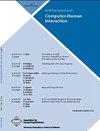稀疏IMU:用于感知细粒度手指微手势的稀疏IMU布局的计算设计
IF 4.8
2区 计算机科学
Q1 COMPUTER SCIENCE, CYBERNETICS
引用次数: 3
摘要
与徒手的手势互动,以及在抓取日常物体时,可以随时获得输入。为了感测这样的手势,用户的手需要最少的仪器。然而,由于包括不同手指手势、对象和抓握的多因子空间的复杂性,选择有效但最小的IMU布局仍然具有挑战性。我们提出了SparseIMU,这是一种快速选择基于最小惯性传感器布局的方法,用于有效的手势识别。此外,我们还提供了一个计算工具来指导设计师优化传感器位置。我们的方法建立在一个由17个惯性测量单元(IMU)组成的密集网络收集的广泛的微测试数据集的基础上。我们进行了一系列分析,包括评估徒手和抓握微手势(393K布局)的整个组合空间,并量化了不同布局选择的性能,揭示了IMU的新手势检测机会。最后,我们用四个场景展示了我们的方法的多功能性。本文章由计算机程序翻译,如有差异,请以英文原文为准。
SparseIMU: Computational Design of Sparse IMU Layouts for Sensing Fine-grained Finger Microgestures
Gestural interaction with freehands and while grasping an everyday object enables always-available input. To sense such gestures, minimal instrumentation of the user’s hand is desirable. However, the choice of an effective but minimal IMU layout remains challenging, due to the complexity of the multi-factorial space that comprises diverse finger gestures, objects, and grasps. We present SparseIMU, a rapid method for selecting minimal inertial sensor-based layouts for effective gesture recognition. Furthermore, we contribute a computational tool to guide designers with optimal sensor placement. Our approach builds on an extensive microgestures dataset that we collected with a dense network of 17 inertial measurement units (IMUs). We performed a series of analyses, including an evaluation of the entire combinatorial space for freehand and grasping microgestures (393 K layouts), and quantified the performance across different layout choices, revealing new gesture detection opportunities with IMUs. Finally, we demonstrate the versatility of our method with four scenarios.
求助全文
通过发布文献求助,成功后即可免费获取论文全文。
去求助
来源期刊

ACM Transactions on Computer-Human Interaction
工程技术-计算机:控制论
CiteScore
8.50
自引率
5.40%
发文量
94
审稿时长
>12 weeks
期刊介绍:
This ACM Transaction seeks to be the premier archival journal in the multidisciplinary field of human-computer interaction. Since its first issue in March 1994, it has presented work of the highest scientific quality that contributes to the practice in the present and future. The primary emphasis is on results of broad application, but the journal considers original work focused on specific domains, on special requirements, on ethical issues -- the full range of design, development, and use of interactive systems.
 求助内容:
求助内容: 应助结果提醒方式:
应助结果提醒方式:


